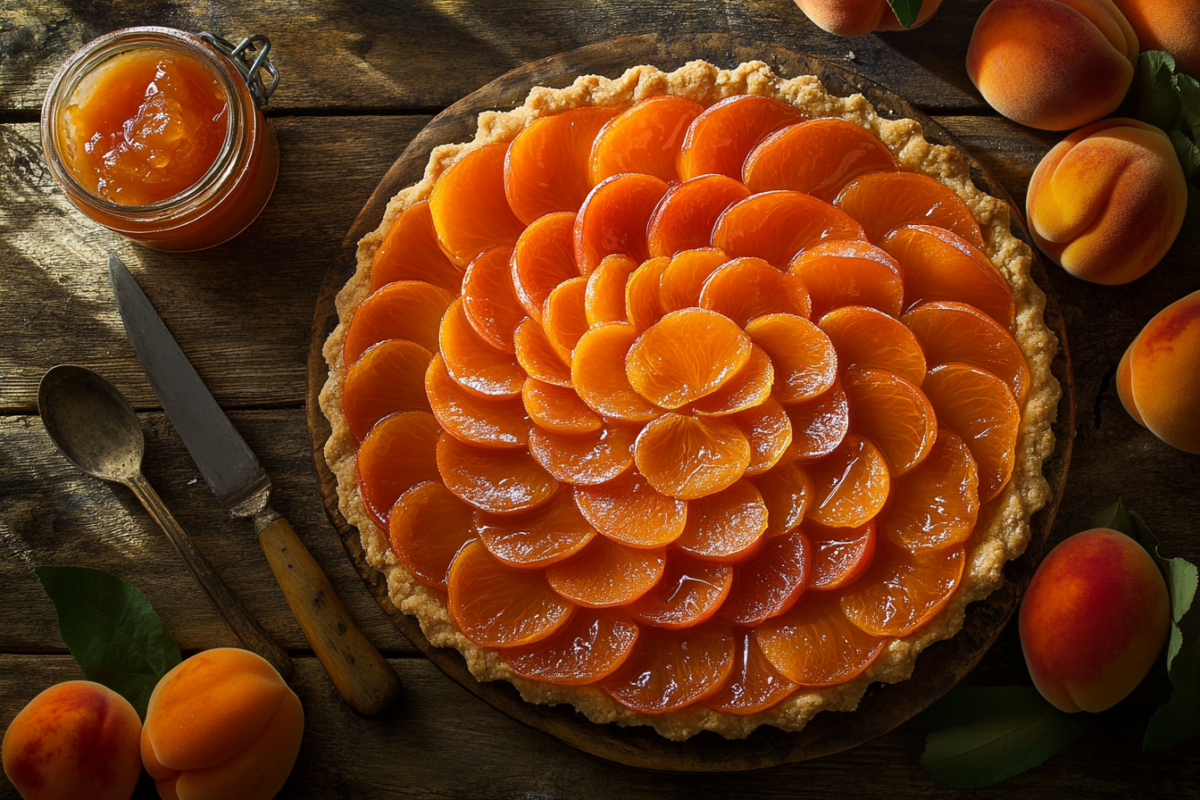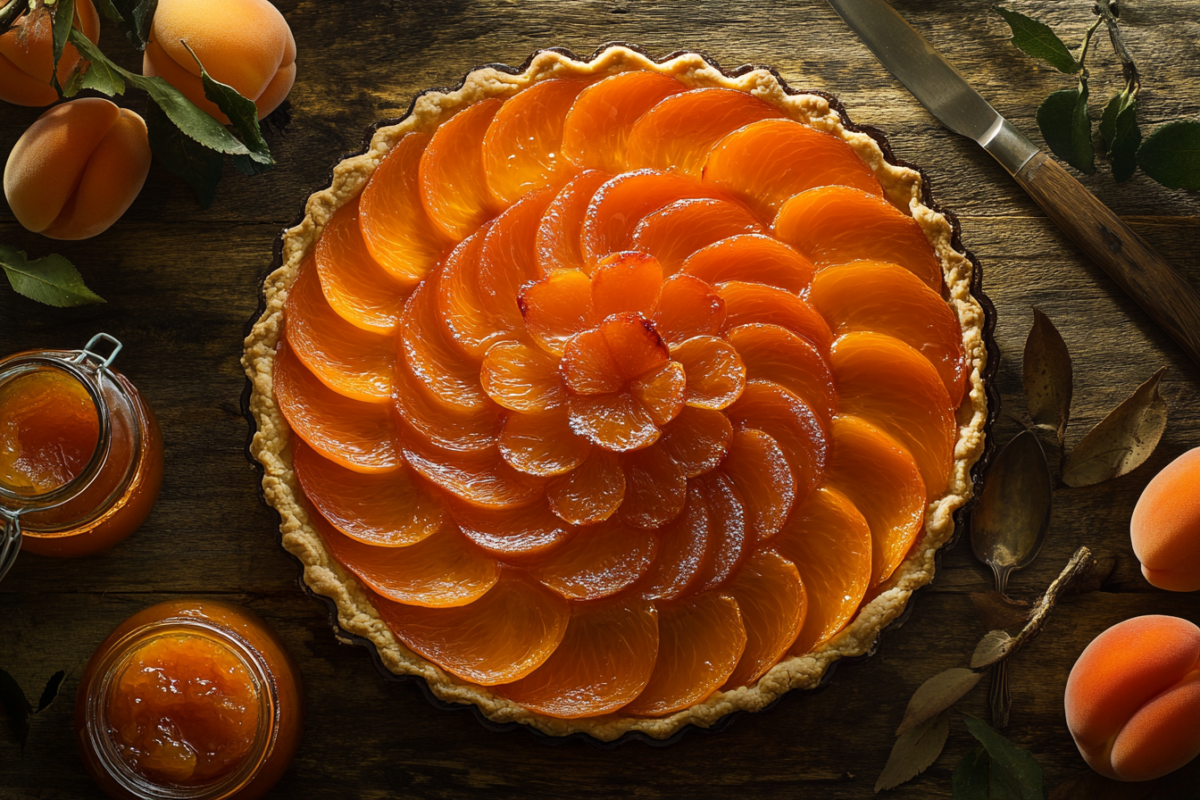Who doesn’t love a dessert that combines the sweetness of ripe apricots with the buttery crunch of a homemade tart crust? This apricot tart recipe will guide you through every step to create a show-stopping treat that’s as delicious as it is beautiful. From understanding the best apricots to use to learning essential baking tips, this guide has it all. So, grab your apron, and let’s dive into the world of perfect apricot tarts!
Introduction to Apricot Tarts
What is an Apricot Tart?
An apricot tart is a delightful dessert that features a flaky pastry crust filled with fresh or preserved apricots. This dessert has a rich history in European cuisine, particularly in French patisserie. It’s loved for its perfect balance of sweetness, tartness, and buttery texture.
Historical Background
Apricots, known as one of the oldest cultivated fruits, have been used in baking for centuries. Early recipes for tarts date back to the 16th century, with apricots being a favorite due to their unique flavor and vibrant color. This makes the apricot tart not just a dessert but a slice of culinary history.
Popularity and Cultural Significance
Whether served as a centerpiece at a summer gathering or enjoyed as a cozy dessert on a chilly evening, apricot tarts have remained a timeless classic. Their versatility allows for countless variations, making them a favorite among both novice bakers and seasoned chefs.
Understanding Apricots
About Apricots
Apricots are small, golden-orange fruits packed with flavor and nutrients. They belong to the stone fruit family, alongside peaches and plums, offering a mildly tangy yet sweet taste that’s perfect for desserts like apricot tarts.
Nutritional Benefits
Not just delicious, apricots are a powerhouse of nutrients! They’re rich in vitamins A and C, which boost skin health and immunity. Additionally, they’re packed with fiber, antioxidants, and potassium, supporting digestion and heart health. Baking with apricots ensures you get a healthy dose of these benefits in every bite.
Seasonality and Availability
Fresh apricots are typically in season from late spring to early summer, making them ideal for summer desserts like tarts. However, thanks to dried and canned varieties, apricots can be enjoyed year-round. For the best flavor, choose fresh apricots during peak season.
Selecting the Best Apricots for Tarts
Fresh vs. Dried Apricots
Fresh apricots offer a juicy, slightly tart flavor that brightens any tart. Meanwhile, dried apricots provide a more concentrated sweetness, making them great for recipes needing less moisture. You can even combine both for a unique flavor profile!
Tips for Choosing Ripe Apricots
To create a truly standout apricot tart, selecting the right fruit is key. Look for apricots that are:
- Vibrant orange with a slight blush.
- Slightly soft to the touch but not mushy.
- Aromatic with a fruity fragrance.
Apricot Tart Variations
Variety is the spice of life, and apricot tarts are no exception! This dessert can be crafted in numerous ways, from elegant French classics to rustic, homestyle creations. Below are some popular variations that cater to every palate.
Classic French Apricot Tart
The Classic French Apricot Tart is a refined dessert with a delicate pastry crust filled with sweet apricots and a smooth glaze. Often paired with a light custard base, this tart embodies sophistication. The apricots are carefully arranged in concentric circles, making it as visually appealing as it is flavorful. It’s perfect for formal dinners or as a centerpiece dessert.
Apricot Frangipane Tart
For those who love almond flavors, the Apricot Frangipane Tart is a must-try. This variation features a rich almond cream layer beneath the apricots, adding a nutty sweetness that complements the fruit’s tangy notes. Frangipane not only enhances the tart’s flavor but also provides a creamy texture, making it a favorite among seasoned bakers.
Rustic Apricot Galette
A Rustic Apricot Galette offers a laid-back alternative to the classic tart. This free-form dessert involves wrapping a flaky pastry dough around apricot slices, creating an unstructured, artisanal look. It’s easy to prepare, requires minimal equipment, and showcases the natural beauty of the fruit. Perfect for casual gatherings or quick baking projects, galettes deliver big flavor with little fuss.
Mini Apricot and Almond Tarts
Looking for individual-sized desserts? Mini Apricot and Almond Tarts are charming, bite-sized versions of their larger counterparts. They’re made with buttery pastry shells filled with apricots and a touch of almond cream or sliced almonds for texture. These tarts are ideal for parties, picnics, or afternoon tea.

Ingredients and Equipment
Creating a delightful apricot tart recipe starts with gathering the right ingredients and tools. Here’s what you’ll need to ensure a flawless dessert.
Essential Ingredients
For the Crust
The crust forms the base of your tart and must strike the perfect balance between buttery richness and flaky texture. You’ll need:
- All-purpose flour
- Unsalted butter (cold and cubed)
- Granulated sugar
- A pinch of salt
- Ice-cold water
For an extra layer of flavor, you can also add a dash of vanilla or almond extract.
For the Filling
The star of the show is, of course, the filling. Key ingredients include:
- Fresh apricots (or dried if fresh is unavailable)
- Sugar (adjustable based on the sweetness of your apricots)
- Lemon juice to enhance tartness
- Cornstarch or flour to thicken the filling
For creamy variations like frangipane, you’ll also need almond flour, eggs, and butter.
Optional Additions
Elevate your tart with:
- A light apricot glaze made from jam or jelly
- Sliced almonds for crunch
- A sprinkling of powdered sugar for garnish
Necessary Equipment
Baking Tools
To craft the perfect tart, you’ll need:
- A tart pan with a removable bottom
- Rolling pin
- Pastry cutter or food processor
Serving Tools
Presentation matters! Serve your tart with:
- A sharp knife for clean slices
- A pie server for easy plating
- Elegant dessert plates to impress your guests
Step-by-Step Apricot Tart Recipe
Preparing the Crust
Ingredients Needed
To get started on your apricot tart crust, gather the following ingredients:
- 1 1/4 cups all-purpose flour
- 1/2 cup of cold unsalted butter, cubed.
- 1/4 cup granulated sugar
- Pinch of salt
- 2-3 tablespoons ice water
Mixing and Rolling the Dough
Begin by combining the flour, sugar, and salt in a bowl. Incorporate the cold butter into the flour using your fingers or a pastry cutter until the mixture forms coarse crumbs. Gradually add ice water, one tablespoon at a time, until the dough begins to form.
Place the dough onto a floured surface and gently knead it a few times until smooth. Shape the dough into a ball, then flatten it into a disc. Wrap it in plastic and put it in the refrigerator for 30 minutes.
Blind Baking Techniques
To ensure your tart crust stays crisp and doesn’t become soggy, blind bake it. Preheat your oven to 375°F (190°C). Roll out your dough into a circle and fit it into your tart pan. Press it into the edges and trim any excess. Line the crust with parchment paper, fill with pie weights or dried beans, and bake for about 15 minutes. Take off the paper and weights, then bake for an additional 5 minutes until lightly golden.
Preparing Apricots
Slice your fresh apricots in half, remove the pits, and cut them into thin wedges. If you’re using dried apricots, soak them in warm water for about 10 minutes to rehydrate before slicing.
Creating the Custard or Frangipane
For a basic custard filling, whisk together sugar, eggs, heavy cream, and a little vanilla extract. Alternatively, for a frangipane filling, blend almond flour, butter, sugar, and eggs to create a smooth, creamy mixture. The frangipane will give your tart a nutty, rich flavor that pairs perfectly with apricots.
Assembling the Tart
Layering the Ingredients
Spread your custard or frangipane evenly across the pre-baked crust. Then, carefully arrange the apricot slices in a fan pattern on top. You can overlap the slices slightly for a beautiful, even look.
Design and Presentation Tips
To add visual appeal, consider placing some sliced almonds around the edges of the apricot slices or sprinkling a little sugar over the top before baking.
Baking Instructions
Optimal Baking Temperatures
Place your tart in a preheated 375°F (190°C) oven and bake for about 30 minutes, or until the crust is golden brown and the filling has set.
Time Guidelines
Depending on your oven, the tart may take a little more or less time. Keep an eye on it, and check that the apricots are tender and the filling is slightly puffed and golden.
Finishing Touches
Glazing the Tart
For a glossy, appetizing finish, brush a thin layer of apricot jam or preserves over the top of the apricots after baking. Heat the jam slightly to make it easier to apply.
Garnishing Suggestions
Sprinkle some powdered sugar on top for a refined touch. You could also add fresh mint or a handful of toasted slivered almonds for extra flavor and texture.
Serving and Pairing
Serving Suggestions for Apricot Tart Recipe
For the best flavor, serve your apricot tart recipe at room temperature or slightly chilled. This ensures that the apricot filling is at its juiciest, and the crust retains its delightful crispness.
Ideal Serving Temperatures for Apricot Tart
Let your apricot tart cool to room temperature before serving to allow the flavors to meld perfectly. If you’re in a rush, a quick chill in the fridge for 15-20 minutes works wonders too.
Accompaniments for Apricot Tart Recipe
This apricot tart recipe pairs beautifully with a dollop of freshly whipped cream or a scoop of vanilla ice cream. The rich creaminess contrasts nicely with the tartness of the apricots, making each bite a balanced experience. For a lighter option, a spoonful of yogurt or mascarpone can elevate the flavor further.
Beverage Pairings for Apricot Tart Recipe
Wine and Tea Recommendations for Apricot Tart
Pair your apricot tart recipe with a crisp white wine, such as Sauvignon Blanc or a light Moscato. For tea lovers, a fragrant Earl Grey or green tea complements the fruity tartness of the apricot beautifully. These beverages enhance the flavors without overpowering them.
Storage and Preservation of Apricot Tart
Storing Leftover Apricot Tart
To store leftover apricot tart, simply cover it with plastic wrap or store it in an airtight container. Keep it in the refrigerator to maintain freshness for up to 2-3 days.
Refrigeration Guidelines for Apricot Tart
Refrigerate your apricot tart as soon as it’s fully cooled. While the crust will soften slightly over time, the flavor will remain fresh, and the apricots will stay delicious.
Freezing Tips for Apricot Tart Recipe
Proper Freezing Methods for Apricot Tart
If you want to freeze your apricot tart recipe, wrap it tightly in plastic wrap and then foil to prevent freezer burn. Freeze for up to 1 month. When you’re ready to serve, let it thaw in the refrigerator overnight.
Shelf Life Considerations for Frozen Apricot Tart
Frozen apricot tarts are best consumed within a month. After thawing, consume within 2-3 days to maintain the best texture and flavor.
Frequently Asked Questions (FAQs) about Apricot Tart Recipe
Can I use canned apricots instead of fresh apricots for my tart recipe?
Yes, canned apricots can be used in a pinch, but fresh apricots offer a brighter flavor and firmer texture. If using canned, be sure to drain them thoroughly to avoid excess liquid.
How do I prevent a soggy crust in my apricot tart recipe?
Blind baking is the key to preventing a soggy crust in your apricot tart recipe. Make sure to bake the crust before adding the filling. If needed, brush the crust with a thin layer of egg wash after blind baking for an extra barrier.
What alternatives can I use for a gluten-free apricot tart crust?
A gluten-free apricot tart crust can be made with almond flour, rice flour, or a gluten-free all-purpose flour blend. Ensure your filling ingredients are also gluten-free to maintain the recipe’s integrity.
Can I substitute apricots with other fruits in my tart recipe?
Yes! Apricots can be replaced with other stone fruits like peaches, plums, or cherries. Berries such as raspberries or strawberries also work well for a different flavor profile.
How do I make my apricot tart recipe less sweet?
To reduce sweetness, you can cut back on the sugar in both the crust and the filling. Consider adding more lemon juice or zest to increase acidity and balance the sweetness of the apricots.
Conclusion on Apricot Tart Recipe
Final Thoughts on Baking Apricot Tarts
Baking an apricot tart recipe is a fun and rewarding experience, whether you’re a seasoned baker or a beginner. The perfect combination of tangy apricots and a flaky crust is sure to impress your family and friends. Don’t be afraid to experiment with variations, and make the recipe your own!

